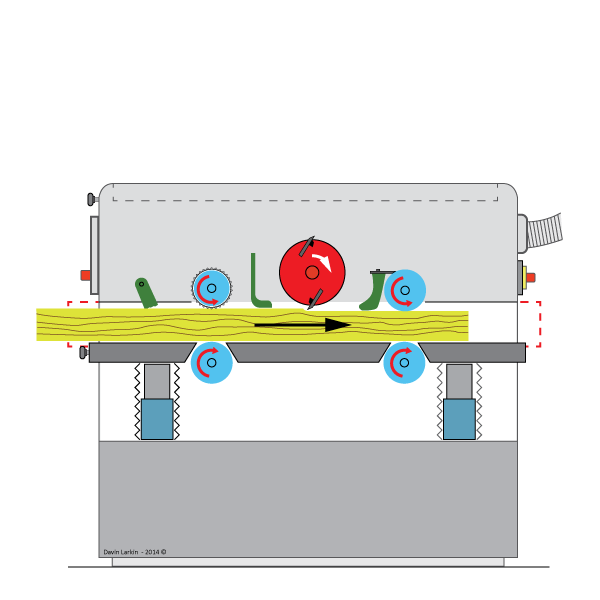Safety
Woodworking machines are highly dangerous even in the hands of a skilled operator. In the interest of your safety it is important to wear Personal Protective Equipment (PPE) at all times when using this machine. Wearing the correct PPE can protect you from projectiles, noise, dust and many other elements.
You are advised to wear ear, eye and foot protection when using this machine.
If you want to learn more about PPE or the laws that require you to wear it, please visit one of the links below.
Personal Protective Equipment and Respiratory Protective Equipment
Publisher: Health & Safety Authority - IRL
Link: http://www.hsa.ie/eng/Topics/Personal_Protective_Equipment_-_PPE/
Personal protective equipment (PPE) at work
Publisher: Health & Safety Executive - UK
Link: http://www.hse.gov.uk/pubns/indg174.pdf
Safe Procedure
Before carrying out any setup or maintenance operations on this machine you MUST first isolate or knock off the electricity supply.
Materials
Length
WWrasp advises planing a minimum length of 300mm on this machine. Alternatively measure the distance between the infeed and outfeed rollers and add 50mm to this dimension to equate your safe minimum material length.
Width
The maximum width of material that can be cut is dependant on the width of the machine table if planing the face or the maximum height the machine table can be set at if planing the edge of your material.
Thickness
WWrasp advises a minimum material thickness of 4mm.
Materials
This machine is mainly used for planing solid wood. WWrasp does not advice using manufactured boards on this machine as it will blunt the cutters at a much faster rate than solid wood.
If you need to plane manufactured boards use a part of the cutterblock that is not often used to ensure it will not effect future planing operations.
Setup
Before switching on the Thicknesser always:
- ensure the machine table is free of grit, chips or resin
- ensure there are no obstacles that could imped your material on the outfeed side of the machine
- measure your material with a callipers and set the depth of cut required
- adjust the feed speed to the required setting
Depth of cut
To set the depth of cut you must adjust the height of the machine table. Measure the widest point of your material and then set the table height to this dimension minus the material you wish to take off.
WWrasp advices a maximum depth of cut as 6mm but on average this should be 2-3mm. This dimension is entirely dependant on the type of machine you are using and the material you are processing.
WWrasp advises a minimum depth of cut as 1mm, anything less will leave serrated marks from the infeed roller on the material surface
Feed Speed
Feed speed determines the pitch distances which define the quality of the finished surface. Thicknessers feed speed range from 0-30 M/min. The slower the feed the better quality surface finish you will achieve. The exact feed speed required for the intended surface finish can be calculated if required.
Operation
During UseAlways plane the width first,(to keep the board as thick as possible), and plane the thickness second.
Place your material with the planed face or edge, down on the machine table. The cutterblock is positioned above the machine table and will plane the top (uneven) surface of your material.
To operate the machine, place your material on the front edge of the machine table, slide it forward until you feel the infeed roller griping the material and pulling it away from you. At this point let go of the material and return to the rear of the machine to collect it when it exits the machine.
When set correctly, this machine will produce a better quality finish than the Surface Planer. The original faces produced on the Surface Planer should be re-planed using the Thicknesser.
Taped components will require a jig, either a bed piece which sits on the machine table or a saddle which travels trhough the machine carrying your material.
WWrasp considers the entire machine table and inner workings of this machine a NO HANDS ZONE.
If your material becomes stuck, turn off the machine, lower the table and remove the material. Never put your hand inside the machine while it is running.
After Use
Switch OFF the machine when finished or when leaving the machine temporarily.
If material is sticking, apply some wax or spray lubricant to reduce friction on the machine table.
Regulations
Thicknessers must be fitted with an anti-kickback device on the operator’s side of the feed roller to restrain any workpiece being accidentally ejected by the machine.
The inspection panel (hood guard) MUST always be in place and closed when operating this machine.





